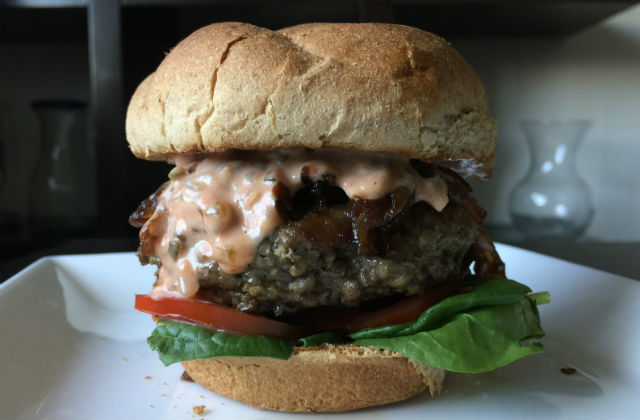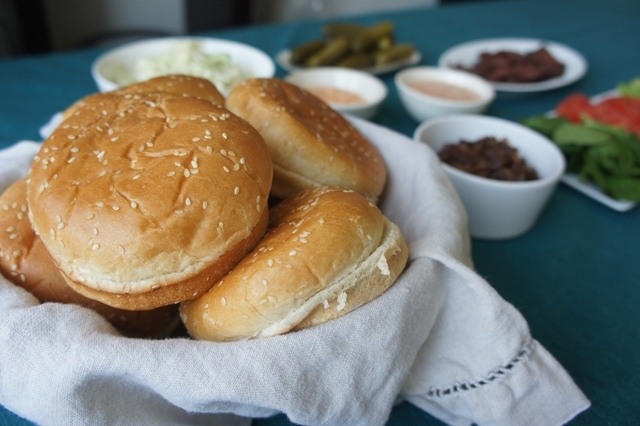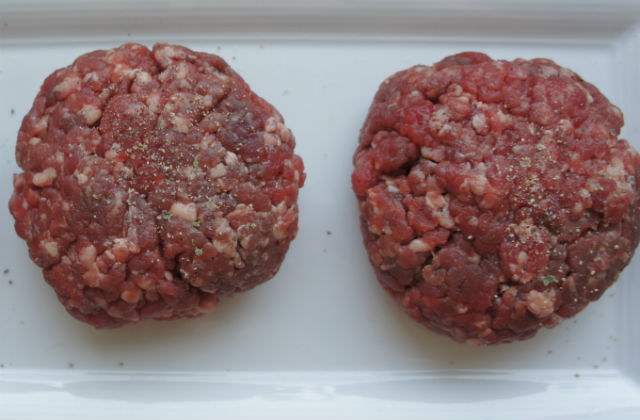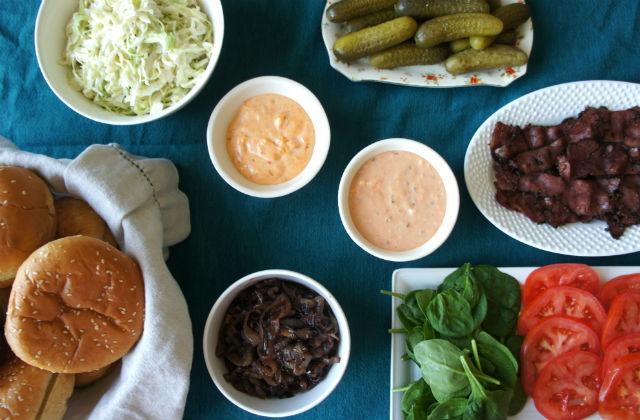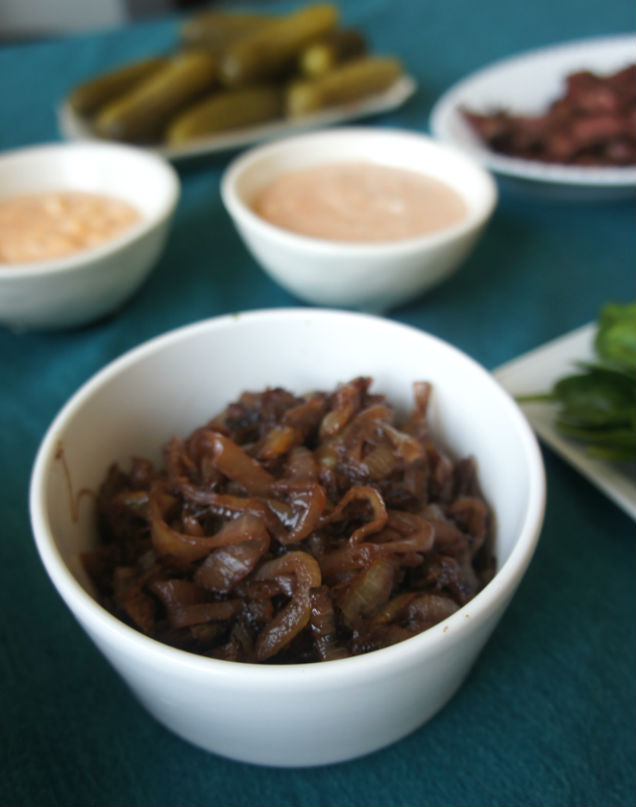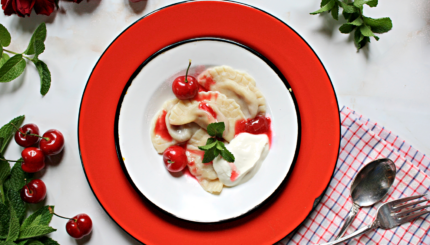The hamburger, and definitely the cheeseburger, is arguably the most iconic American food. You would be hard pressed to find a person who doesn’t love a good burger. But can the cheese-less burger compare? In New York recently, gourmet kosher burgers have been all the rage. Three upscale kosher burger joints have opened in the past few years alone to much enthusiasm and even some decent reviews: Amsterdam Burger, Gotham Burger, and most recently Boeuf & Bun.
But aside from the recent surge of upscale kosher burger joints, most kosher burgers (at least for me) just don’t compare to their non-kosher counterpart. Over the past year or so I have dedicated some signficant time working to combat this, at least in my home kitchen, with fun, fabulous, juicy homemade kosher burgers. Creative toppings are part of a great burger experience for me, but also starting with quality ingredients and a few key techniques can really make the difference between average and exceptional.
During my onerous, burger-consuming experiments I realized one of the secrets to what I consider a great burger at home: grinding your own meat. I know, I know – this might sound crazy and way too complicated to attempt, but in fact it is an easy switch that produces a big difference in taste. I have always used my handy meat grinder attachment when making Italian-style meatballs like my mother made growing up, but when I made the switch to grinding meat for burgers, wow was I blown away. It’s only about $30 and what I consider a worthy investment, not just for burgers, but lots of dishes.
The Nosher celebrates the traditions and recipes that have brought Jews together for centuries. Donate today to keep The Nosher's stories and recipes accessible to all.
When you grind your own meat, make sure it is very cold. Don’t take it out of the fridge until you are ready to grind it. And if you are so inclined, you can pop it in the freezer 10 minutes before you are ready to grind. You can also place the actual grinder in the freezer. Yes, put the whole contraption right in the freezer.
Don’t buy a lean steak – make sure to get something with some nice marbling. I often use pre-cut stewing meat, since it is already cut into appropriately sized chunks for pushing through the meat grinder. If you cut up a steak yourself for this project, make sure not to cut the chunks too large.
As you grind you will immediately see such a difference in the texture and color of the meat. For more tips on grinding meat check out this great post on what is the best way to grind beef at home.
To make burgers at home, I measure out around 1/3 lb ground beef per person. I form each into a patty, packing tight, but not overworking the meat, and place onto a platter to chill until I am ready to cook. Yes, you can freeze them at this point. I would place them between pieces of parchment paper and then place into a freezer-safe bag. When I am ready to cook the burgers, I take them out of the fridge for 10-20 minutes and then sprinkle each side simply with salt and pepper.
We live in an apartment and don’t have regular access to a grill, so I like using a cast iron skillet which is a great investment for any home-cook. Cook the burgers on each side until your desired doneness. The cast iron skillet forms a great crust on each side, while the inside of the burger remains juicy.
But remember when using a cast iron skillet you cannot wash it with soap because you may strip the seasoning. The Kitchn has great instructions for how to take good care of a cast iron skillet so make sure to read through it if you are using a cast iron skillet for the first time.
One of the other fun ways I have upped my burger game at home is by trying out lots of different toppings: everything from gribenes and grilled pastrami to veggies and caramelized onions. I have a few ideas below, but the sky is the limit! Invite your friends over and ask each to bring a unique burger topping. Let guests top their own burgers for a completely unique and delicious gathering. The mediocre kosher burger of the past will be all but forgotten.
Some topping suggestions:
- spinach, arugula, shredded iceberg lettuce or other favorite greens
- sliced tomato
- sliced red onions
- sliced avocado or guacamole
- sautéed mushrooms
- homemade coleslaw (see recipe below)
- flavored mayo like chipotle mayo (see recipe below)
- grilled pastrami
- chopped liver
- grilled sausages like these spicy Jack’s Mexican-Style Chorizo
- lamb bacon like this one from Kol Foods
- pulled brisket
- gribenes (fried chicken skin)
- homemade dill pickles
- mango red pepper salsa
- Pinot Noir caramelized onions (see recipe below)
Pinot Noir Caramelized Onions
INGREDIENTS
2 large onions
olive oil
salt and pepper
2 Tbsp sugar
3/4 cup Pinot Noir or other red wine
DIRECTIONS
Heat a large saute pan over low-medium heat. Add a few Tbsp olive oil and once the oil is shimmering, add the onions and season lightly with salt and pepper. Saute on low-medium heat for at least 30 minutes, stirring continually. After 30 minutes add 2 Tbsp sugar.
Continue to saute, stirring occasionally. After another 15 minutes add 1/4 cup pinot noir (or other red wine). Keep stirring, scraping any bits off the bottom. Wine will reduce.
After 15 minutes repeat with another 1/4 cup wine. Scrape and stir once again and allow wine to reduce.
Repeat one last time after 15 minutes and let onions cook until wine is completely reduced and onions are a deep color.
Horseradish Coleslaw
INGREDIENTS
10 oz bag of cabbage or coleslaw mix
1/2 cup mayo
1 heaping Tbsp horseradish
2 Tbsp white vinegar
2 tsp agave syrup
1 tsp dijon or spicy mustard
salt and pepper to taste
DIRECTIONS
In a large bowl, whisk together mayo, horseradish, white vinegar, agave syrup, mustard and salt and pepper.
Add bag of cabbage or coleslaw mix until completely covered. Refrigerate for at least an hour before servings.
Spicy Chipotle Mayo
INGREDIENTS
1 cup mayo
2 Tbsp chipotle sauce in adobo sauce
1 chipotle pepper in adobo sauce, minced
salt and pepper to taste
DIRECTIONS
In a small bowl, mix all ingredients together. Serve with burgers, fries or sandwiches
